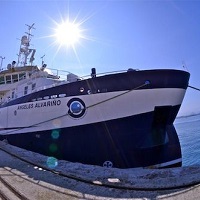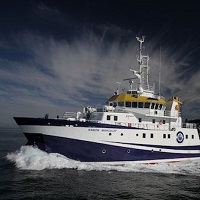Keyword
cameras
158 record(s)
Type of resources
Categories
Topics
INSPIRE themes
Keywords
Contact for the resource
Provided by
Years
Formats
Status
-

1.Estimar índices de abundancia de reclutas y juveniles de langosta. 2.Determinar la estructura demográfica y distribución batimétrica de los juveniles. 3.Estimar la abundancia y demografía de la langosta mediante técnicas de video sumergido con cebo. 4.Evaluar el efecto de la ampliación de la reserva marina mediante video sumergido y censos visuales. 5.Obtener muestras de ejemplares recién asentados talla inferior a 15 mm LC (Longitud de Cefalotórax) para estudios de genética de poblaciones y composición isotópica.
-

Research and identification of sunken vessels
-

Se pretende continuar con las labores acometidas en la Primera Campaña realizada en el 2015 en lo referido al conocimiento del pecio: - Extensión del pecio. - Estado de conservación de los materiales. - Dispersión de los restos del buque español. - Continuar con el “mapeado” arqueológico. - Avanzar en la interpretación y análisis del pecio. - Extracción de los siguientes elementos, basada en motivaciones de carácter histórico‐culturales, museográficas, de conservación, archivísticas y jurídicas: a.‐ Culebrina de bronce del siglo XVI. Peso aproximado: entre 1.300 y 1.800 Kg. b.‐ Un “cañón pedrero” u “obús de a tres”, de bronce. Pareja del extraído en 2015. c.‐ Elementos de la vajilla de plata estropeada (plata de chafalonía) que figura en la documentación del AGI. d.‐ También se extraerán algunos elementos que en el 2015 se filmaron y cuya función desconocemos. e.‐ Dependiendo de las circunstancias de la Campaña, es posible que se proceda a extraer la segunda culebrina de la Mercedes.
-

1.- Se pretende ubicar en la estricta verticalidad del pecio un barco de tecnología moderna que tenga la posibilidad de transportar y hacer operativo un ROV. Dicho ROV deberá ser capaz de descender hasta los 1200 metros del objetivo, y pasar varias horas de trabajo diarias filmando y fotografiando los restos del pecio. Por lo tanto debe entenderse que la clara finalidad de esta Campaña estriba en la documentación, “mapeado” arqueológico e interpretación y análisis del estado actual del pecio. 2.- Además de lo anterior, se pretende realizar la cartografía de la zona de hundimiento de la Fragata Nuestra Señora de Las Mercedes. Para ello, con la sonda multihaz EM710 se llevará a cabo un levantamiento batimétrico sistemático de la zona del hundimiento con recubrimiento redundante solapando al 100%, con los haces cerrados al máximo y velocidad no superior a 5 nudos. De estemodo, se consigue una elevada densidad de puntos sondados que permitirá realizar una cartografía de gran resolución.
-

Mantenimiento de los colectoresprofundos de langosta, obtención de larvas filosomas y filmaciones submarinas con video cebado.
-

Mantenimiento de los colectoresprofundos de langosta, obtención de larvas filosomas y filmaciones submarinas con video cebado.
-
<p style="text-align:justify">The main objective of the observing system MOOSE is to monitor the long-term evolution of the north-western Mediterranean Sea (over more than 10 years) in the context of climate change and anthropogenic pressure in order to detect and identify the trend and environmental anomalies of the marine ecosystem. The MOOSE network aims to establish an integrated and multidisciplinary system in the Mediterranean Sea in accordance with the objectives of the national MISTRALS program (HyMeX, MeRMEX and ChARMeX). The MOOSE system is supported by national institutes (CNRS-INSU, French Ministry of Higher Education and Research) and involved different partners (Universities, IFREMER, Meteo France).</p> <p style="text-align:justify">The MOOSE network includes "multi-scale" measurement capabilities to accurately document the broad spectrum of hydrodynamic processes already identified (large scale eddies, mesoscale eddies, biogeochemical provinces). High temporal resolution measurements are obtained from fixed observatories (moorings, buoys) but their spatial distribution remains insufficient. Spatial variability is of the same order as temporal variability and understanding the evolution of this basin as a whole implies being able to dissociate both. Synergy with other strategies (ships, floats, gliders) is essential for the establishment of an observation network in such a system. To address the issues identified by MOOSE, two key areas of the north-western basin have been identified:</p> <ul> <li style="text-align:justify">The central and western part of the Ligurian Sea, which constitutes a homogeneous system isolated from direct coastal inputs by rivers and where atmospheric inputs are predominant (DYFAMED and ANTARES). It is also one of the entrance passages of the Intermediate Levantine Water (LIW) in the north-western Mediterranean basin.</li> <li style="text-align:justify">The central area of the Gulf of Lion where winter cooling leads to vertical mixing over 2000 m and sometimes to the bottom. The LION site (42°N 5°E) is ideal for studying the variability of winter convection to better understand mixing processes and dense water formation. It also characterizes the variability of the deep particle flow.</li> </ul> <p style="text-align:justify">Currently, fixed observation at these sites is carried out by six moorings:</p> <ul> <li style="text-align:justify">The Planier and Lacaze-Duthiers moorings composed of sediment traps and T/S sensors and current meters, for dense water cascading and particle export studies. These moorings have been set up since 1994 and managed by CEFREM.</li> <li style="text-align:justify">The LION mooring, consisting of a large number of T/S sensors, current meters, and two oxygen sensors, is in the Gulf of Lion convection zone. It has been deployed since 2007, and is managed by CEFREM and LOCEAN. A sediment trap near the bottom has also been present for 2 years in this area (LIONCEAU mooring). The latter will be integrated into the LION mooring in 2019.</li> <li style="text-align:justify">The ANTARES mooring is located in the North Current off Toulon and equipped with T/S sensors, current meters and oxygen sensors to quantify the bacteria activity and organic matter remineralization process in a deep marine environment. It exists since 2004, it is managed by the M.I.O. and the CPPM (Marseille). This mooring is part of the ERIC EMSO since 2017.</li> <li style="text-align:justify">The DYFAMED mooring, in the Ligurian Sea, equipped with sediment traps, T/S sensors, current meters and oxygen sensors to monitor the evolution of the water column, the impact of atmospheric dust deposition and marine particles export to deep waters. It exists since 1988, it is currently managed by the Oceanological Observatory of Villefranche-sur-Mer. This mooring is part of the ERIC EMSO since 2017.
-
<p style="margin-left:0cm; margin-right:0cm">The objective of the campaign PELMED is to estimate the biomasses of small pelagic fish of the Gulf of Lion by acoustic method and to collect a maximum of parameters at each level of the trophic chain. This approach aims towards a more and more ecosystematic campaign(countryside), what is in adequacy with the Directive Centre Strategy for the Marine environment (DCSMM) and the objectives of the UMR MARBEC.</p>
-

Development of underwater photogrammetry system for Marine Renewable Energy
-

Evaluation of the impact and interaction of gill art aimed at (Scratch) with the bottom, with the benthic species and with the habitats
 Catálogo de datos del IEO
Catálogo de datos del IEO